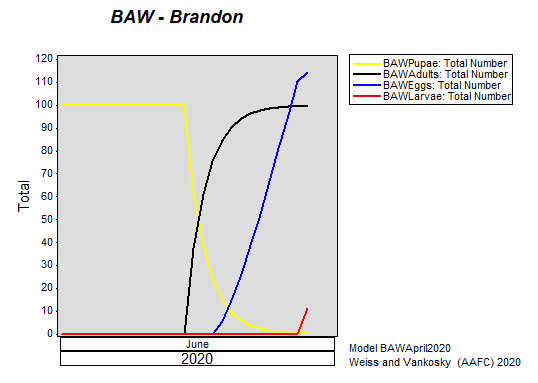Development near Brandon (Fig. 2) is predicted to be ahead of fields near Saskatoon (Fig. 3). First instar larvae are predicted to be occurring in southern Manitoba (Fig. 3).
 |
| Figure 1. Predicted percent of bertha armyworm (Mamestra configurata) population at adult stage as of June 28, 2020. |
 |
| Figure 2. Predicted bertha armyworm (Mamestra configurata) phenology at Saskatoon SK as of June 28, 2020. |
 |
| Figure 3. Predicted bertha armyworm (Mamestra configurata) phenology at Brandon MB as of June 28, 2020. |
 |
| Figure 4. Stages of bertha armyworm from egg (A), larva (B), pupa (C) to adult (D). Photos: J. Williams (Agriculture and Agri-Food Canada) |
Weekly Pheromone-baited Trapping Results - Early season detection of bertha armyworm is improved through the use of pheromone-baited unitraps traps deployed in fields across the Canadian prairies. Click each province to access moth reporting numbers observed in Alberta, Saskatchewan and Manitoba as they become available. Check these sites to assess cumulative counts and relative risk in your geographic region.
Refer to the PPMN Bertha armyworm monitoring protocol for help when performing in-field scouting. Use the images above (Fig. 4) to help identify egg masses and the economically important larvae in canola. Review the 2019 Insect of the Week which featured bertha armyworm and its doppelganger, the clover cutworm!
Biological and monitoring information related to bertha armyworm in field crops is posted by the provinces of Manitoba, Saskatchewan, Alberta and the Prairie Pest Monitoring Network. Also refer to the bertha armyworm pages within the "Field Crop and Forage Pests and their Natural Enemies in Western Canada: Identification and management field guide" which is a free downloadable document as both an English-enhanced or French-enhanced version.
Biological and monitoring information related to bertha armyworm in field crops is posted by the provinces of Manitoba, Saskatchewan, Alberta and the Prairie Pest Monitoring Network. Also refer to the bertha armyworm pages within the "Field Crop and Forage Pests and their Natural Enemies in Western Canada: Identification and management field guide" which is a free downloadable document as both an English-enhanced or French-enhanced version.